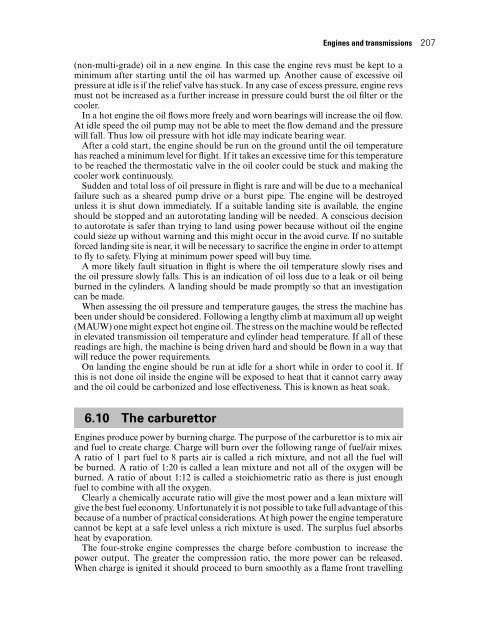The Art of the Helicopter John Watkinson - Karatunov.net
The Art of the Helicopter John Watkinson - Karatunov.net
The Art of the Helicopter John Watkinson - Karatunov.net
Create successful ePaper yourself
Turn your PDF publications into a flip-book with our unique Google optimized e-Paper software.
Engines and transmissions 207<br />
(non-multi-grade) oil in a new engine. In this case <strong>the</strong> engine revs must be kept to a<br />
minimum after starting until <strong>the</strong> oil has warmed up. Ano<strong>the</strong>r cause <strong>of</strong> excessive oil<br />
pressure at idle is if <strong>the</strong> relief valve has stuck. In any case <strong>of</strong> excess pressure, engine revs<br />
must not be increased as a fur<strong>the</strong>r increase in pressure could burst <strong>the</strong> oil filter or <strong>the</strong><br />
cooler.<br />
In a hot engine <strong>the</strong> oil flows more freely and worn bearings will increase <strong>the</strong> oil flow.<br />
At idle speed <strong>the</strong> oil pump may not be able to meet <strong>the</strong> flow demand and <strong>the</strong> pressure<br />
will fall. Thus low oil pressure with hot idle may indicate bearing wear.<br />
After a cold start, <strong>the</strong> engine should be run on <strong>the</strong> ground until <strong>the</strong> oil temperature<br />
has reached a minimum level for flight. If it takes an excessive time for this temperature<br />
to be reached <strong>the</strong> <strong>the</strong>rmostatic valve in <strong>the</strong> oil cooler could be stuck and making <strong>the</strong><br />
cooler work continuously.<br />
Sudden and total loss <strong>of</strong> oil pressure in flight is rare and will be due to a mechanical<br />
failure such as a sheared pump drive or a burst pipe. <strong>The</strong> engine will be destroyed<br />
unless it is shut down immediately. If a suitable landing site is available, <strong>the</strong> engine<br />
should be stopped and an autorotating landing will be needed. A conscious decision<br />
to autorotate is safer than trying to land using power because without oil <strong>the</strong> engine<br />
could sieze up without warning and this might occur in <strong>the</strong> avoid curve. If no suitable<br />
forced landing site is near, it will be necessary to sacrifice <strong>the</strong> engine in order to attempt<br />
to fly to safety. Flying at minimum power speed will buy time.<br />
A more likely fault situation in flight is where <strong>the</strong> oil temperature slowly rises and<br />
<strong>the</strong> oil pressure slowly falls. This is an indication <strong>of</strong> oil loss due to a leak or oil being<br />
burned in <strong>the</strong> cylinders. A landing should be made promptly so that an investigation<br />
can be made.<br />
When assessing <strong>the</strong> oil pressure and temperature gauges, <strong>the</strong> stress <strong>the</strong> machine has<br />
been under should be considered. Following a lengthy climb at maximum all up weight<br />
(MAUW) one might expect hot engine oil. <strong>The</strong> stress on <strong>the</strong> machine would be reflected<br />
in elevated transmission oil temperature and cylinder head temperature. If all <strong>of</strong> <strong>the</strong>se<br />
readings are high, <strong>the</strong> machine is being driven hard and should be flown in a way that<br />
will reduce <strong>the</strong> power requirements.<br />
On landing <strong>the</strong> engine should be run at idle for a short while in order to cool it. If<br />
this is not done oil inside <strong>the</strong> engine will be exposed to heat that it cannot carry away<br />
and <strong>the</strong> oil could be carbonized and lose effectiveness. This is known as heat soak.<br />
6.10 <strong>The</strong> carburettor<br />
Engines produce power by burning charge. <strong>The</strong> purpose <strong>of</strong> <strong>the</strong> carburettor is to mix air<br />
and fuel to create charge. Charge will burn over <strong>the</strong> following range <strong>of</strong> fuel/air mixes.<br />
A ratio <strong>of</strong> 1 part fuel to 8 parts air is called a rich mixture, and not all <strong>the</strong> fuel will<br />
be burned. A ratio <strong>of</strong> 1:20 is called a lean mixture and not all <strong>of</strong> <strong>the</strong> oxygen will be<br />
burned. A ratio <strong>of</strong> about 1:12 is called a stoichiometric ratio as <strong>the</strong>re is just enough<br />
fuel to combine with all <strong>the</strong> oxygen.<br />
Clearly a chemically accurate ratio will give <strong>the</strong> most power and a lean mixture will<br />
give <strong>the</strong> best fuel economy. Unfortunately it is not possible to take full advantage <strong>of</strong> this<br />
because <strong>of</strong> a number <strong>of</strong> practical considerations. At high power <strong>the</strong> engine temperature<br />
cannot be kept at a safe level unless a rich mixture is used. <strong>The</strong> surplus fuel absorbs<br />
heat by evaporation.<br />
<strong>The</strong> four-stroke engine compresses <strong>the</strong> charge before combustion to increase <strong>the</strong><br />
power output. <strong>The</strong> greater <strong>the</strong> compression ratio, <strong>the</strong> more power can be released.<br />
When charge is ignited it should proceed to burn smoothly as a flame front travelling










